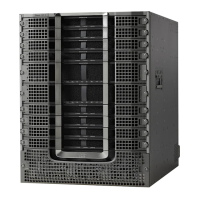Different new time-slot scheduling disciplines help in providing guaranteed delay and jitter bound on shared
upstream. Activity detection helps to conserve link bandwidth by not issuing time slots for an inactive service
flow. The conserved bandwidth can then be reused for other best-effort data slots.
Packet classification helps the CMTS and cable modem to isolate different types of traffic into different
DOCSIS service flows. Each flow could be receiving a different QoS service from CMTS.
Fragmentation
Fragmentation splits large data packets so that they fit into the smaller time slots inbetween UGS slots. This
reduces the jitter experienced by voice packets when large data packets are transmitted on the shared upstream
channel and preempt the UGS slots used for voice.
Multiple Subflows per SID
This feature allows the cable modem to have multiple calls on a single hardware queue. This approach scales
much better than requiring a separate SID hardware queue on the cable modem for each voice call.
Payload Header Suppression
Payload Header Suppression (PHS) allows the CMTS and cable modem to suppress repetitive or redundant
portions in packet headers before transmitting on the DOCSIS link. This conserves link bandwidth, especially
with types of traffic such as voice, where the header size tends to be as large as the size of the actual packet.
Service Classes
The use of the service class provides the following benefits for a DOCSIS 1.1 network:
•
It allows operators to move the burden of configuring service flows from the provisioning server to the
CMTS. Operators provision the modems with the service class name; the implementation of the name
is configured at the CMTS. This allows operators to modify the implementation of a given service to
local circumstances without changing modem provisioning. For example, some scheduling parameters
might need to be set differently for two different CMTSs to provide the same service. As another example,
service profiles could be changed by time of day.
•
It allows CMTS vendors to provide class-based-queuing if they choose, where service flows compete
within their class and classes compete with each other for bandwidth.
•
It allows higher-layer protocols to create a service flow by its service class name. For example, telephony
signaling might direct the cable modem to instantiate any available provisioned service flow of class
G.711.
The service class is optional. The flow scheduling specification may always be provided in full; a service
flow may belong to no service class whatsoever. CMTS implementations may treat such unclassed flows
differently from classed flows with equivalent parameters.
Note
How to Configure the Cisco CMTS for DOCSIS 1.1 Operations
See the following sections for the configuration tasks for DOCSIS 1.1 operations. Each task in the list is
identified as either required or optional.
Cisco cBR Series Converged Broadband Routers Quality of Services Configuration Guide for Cisco IOS XE Fuji
16.7.x
47
DOCSIS 1.1 for the Cisco CMTS Routers
How to Configure the Cisco CMTS for DOCSIS 1.1 Operations

